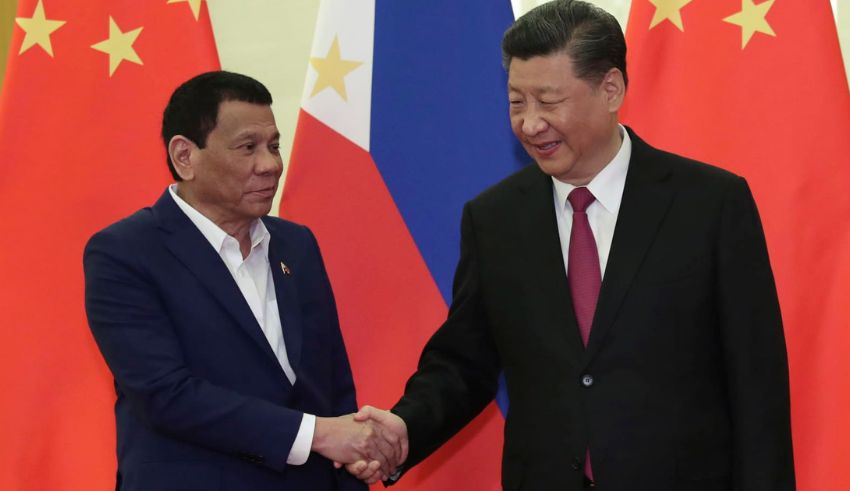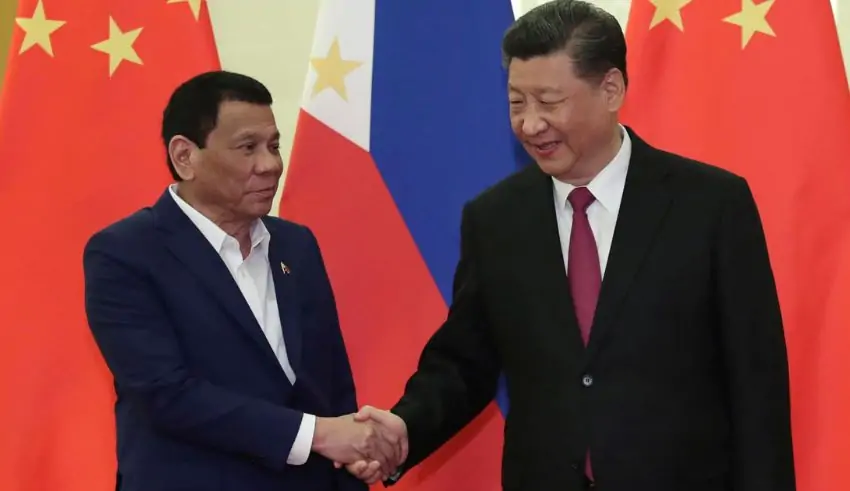

(C) CNBC
For the first time, China has publicized what it claims is an unwritten 2016 agreement with the Philippines over access to South China Sea islands. The move threatens to further raise tensions in the disputed waterway, through which much of the world’s trade passes and which China claims virtually in its entirety.
According to a statement from the Chinese Embassy in Manila, the “temporary special arrangement” that former president Rodrigo Duterte agreed upon during a visit to Beijing permitted small-scale fishing around the islands but limited military, coast guard, and other official plane and ship access to the 12 nautical mile (22 kilometer) boundary of territorial waters.
After honoring the deal for the previous seven years, the Philippines broke it to “fulfill its own political agenda,” according to the statement, compelling China to act.
The statement alluding to the activities of the Philippines said, “This is the basic reason for the ceaseless disputes at sea between China and the Philippines over the past year and more.”
Both President Duterte and Ferdinand Marcos Jr. have denied creating any agreements that would have ostensibly given China Philippine sovereignty or sovereign powers. The 1987 Constitution of the nation would make any such act an impeachable offense if it were proven.
June 2022 saw the inauguration of President Ferdinand Marcos, who told reporters last month that although China has maintained the existence of such a secret deal, he was unaware of it.
Over his six-year presidency, Duterte developed strong ties with Chinese President Xi Jinping while publicly remaining hostile to the US for its severe criticism of his bloody campaign on illegal drugs.
He has said that, although taking a sternly anti-American stance during his 2016 visit to Washington’s primary enemy, he did not sign any documents with Beijing that would have endangered Philippine territory. He did admit that they had agreed to maintain “the status quo” in the contested seas in order to avoid confrontation.
“The only thing I recall, other than shaking hands with President Xi Jinping, is that status quo. As things are, there won’t be any interaction, movement, or armed patrols there, hence there won’t be any confrontation,” Duterte added.
When questioned if he agreed that the Philippines would not supply building supplies to fortify a Philippine naval ship station at Second Thomas Shoal, Duterte indicated that was a necessary component of keeping things as they were, but he also mentioned that there was no formal agreement.
“A gentleman’s agreement would have always been one to maintain peace in the South China Sea,” Duterte stated.
China has further said that Philippine authorities have pledged to remove the navy ship that was purposefully stranded in the Second Thomas Shoal’s shallows in 1999 in order to act as Manila’s territorial outpost. Under Marcos, Philippine officials claimed ignorance of any such arrangement and refused to withdraw the now-rust-encrusted, run-down vessel, which was manned by a limited number of Filipino sailors and marines.
Without being specific, China has long charged Manila of “violating its commitments” and “acting illegally” in the South China Sea.
Apart from China and the Philippines, Vietnam, Malaysia, Taiwan, and Brunei also have overlapping claims in the rich gas and oil fishing supplies. Beijing has rejected a 2016 international arbitration ruling that was denied its extensive claims on historical grounds by a UN-affiliated court at the Hague.
Massive Chinese coast guard cutters have been shooting high-pressure water cannons at Philippine patrol vessels, most recently off Scarborough Shoal late last month, damaging both, inflaming tensions between Beijing and Manila since last year. They have also caused little scrapes by accusing one another of risky maneuvering.
The United States has sent Navy ships and fighter fighters into what it refers to as freedom of navigation operations that have contested China’s claims, but it has no claims to the South China Sea.
If Filipino forces, ships, or aircraft come under an armed attack, even in the South China Sea, the United States has repeatedly warned that it is required to defend the Philippines, its oldest treaty partner in Asia.
Early Tuesday morning. The fire, which could be seen from several miles away, caused mass evacuations as the authorities fine-tuned…
OpenAI's new image creation option on ChatGPT attracted many users in a short time. ChatGPT achieved its one million user…
Yuki Tsunoda has targeted a dream podium at his home Japanese Grand Prix following his surprise elevation to Red Bull.…
Finally, it is out! Tom Holland will return to the red and blue suit as Marvel formally launches the title…
Turkish music lovers and the whole entertainment world on Sunday night were put in shock by the unexpected passing of…
The Senior Asian Wrestling Championship 2025 held in Amman closed with an exhilarating finale for India. The freestyle wrestling contingent…
This website uses cookies.
Read More